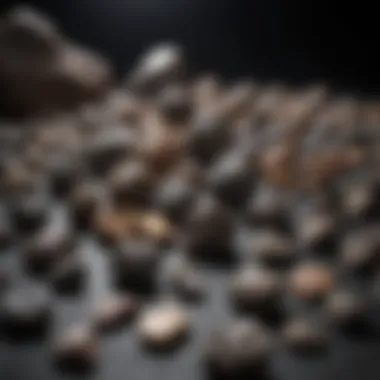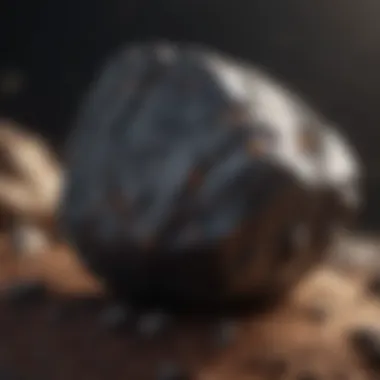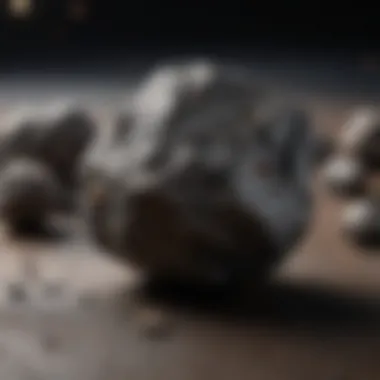Navigating the Market: Purchasing Meteorites


Intro
Purchasing meteorites is an intriguing venture for collectors and enthusiasts alike. These celestial stones, with origins that trace back millions of years, touch on both the scientific and the artistic. As you dive into the world of meteorites, it becomes clear that the market offers a blend of adventure, rarity, and, yes, a fair bit of risk. So, how can you navigate this unique marketplace?
In this guide, we’ll peel back the layers of purchasing meteorites. From understanding what makes these pieces of space history valuable to knowing where and how to buy them, this journey will arm you with the knowledge needed to make sound investments. Let’s kick things off by first understanding what exactly a meteorite is and why these rare finds continue to capture the attention of collectors around the globe.
Understanding Meteorites
Understanding meteorites is the first step for anyone looking to dive into the world of celestial rocks. Having a solid grasp of what these pieces of space debris are not only enriches the experience of collecting but also aids in navigating the market effectively. They aren’t just rocks from outer space; they’re fragments of our solar system's history, holding secrets of planetary formation and evolution. By familiarizing oneself with these essential features, collectors can make informed decisions and truly appreciate the nuances behind each specimen they consider purchasing.
What Constitutes a Meteorite?
A meteorite is a solid fragment of a meteoroid that survives its passage through the Earth’s atmosphere and lands on the ground. This means that, before it can be classified as a meteorite, a meteoroid must endure intense heat and pressure during entry. The defining factors include:
- Survival of Atmospheric Entry: Approximately 91% of meteoroids burn up in the atmosphere.
- Landing on Earth: Only a select few make it through as intact samples.
- Physical Characteristics: Once on the ground, meteorites often exhibit unique features like regmaglypts or fusion crusts, which help distinguish them from terrestrial rocks.
Understanding these elements lays the groundwork for appreciating the rarity and value of meteorites.
Classification of Meteorites
Meteorites can be categorized into three main classes: stony, iron, and stony-iron, each contributing differently to the collector's landscape.
Stony Meteorites
Stony meteorites are the most commonly found type, accounting for about 94% of all meteorites. These pieces are primarily composed of silicate minerals. They often come from asteroids and sometimes from the Moon or Mars. The key characteristics that make stony meteorites appealing are:
- Diverse Appearances: With numerous varieties such as chondrites and achondrites, they can range widely in look and texture.
- Accessibility for Collectors: Thanks to their prevalence, stony meteorites are often more readily available.
However, it’s crucial to note that their abundance can sometimes diminish perceived value among collectors.
Iron Meteorites
Iron meteorites are strikingly distinct due to their metallic composition, usually consisting of iron-nickel alloys. This category makes up about 5% of meteorites and offers unique benefits:
- Durability: They tend to be more resilient compared to stony counterparts.
- Appealing Patterns: When polished, they exhibit beautiful Widmanstätten patterns, which display a unique crystalline structure.
Nevertheless, they can be heavy and more expensive, given their rarity compared to stony types.
Stony-Iron Meteorites
Stony-iron meteorites are a fascinating blend of both stony and metallic components. While they make up only about 1% of meteorites found, their hybrid nature makes them particularly captivating. Key traits worth noting include:
- Unique Composition: They exhibit both silicate minerals and metallic elements.
- Portion of Visual Appeal: These meteorites often provide a rare combination of the aesthetic qualities of both stony and iron meteorites, making them a coveted choice among collectors.


However, being part of the rarer class, they typically come with a higher price tag, which may affect accessibility for new collectors.
"Having a firm knowledge of meteorite classifications is crucial for any serious collector. It influences decisions around authenticity, value, and investment in the long run."
Where to Purchase Meteorites
Finding the right place to purchase meteorites is essential for both novice collectors and seasoned enthusiasts. Understanding the various sources available can significantly impact your purchasing decisions. Each option comes with its own set of benefits, considerations, and potential pitfalls. The ultimate goal is to ensure that you acquire genuine pieces of celestial history that hold their value over time.
Authorized Dealers
Authorized dealers stand as a pillar of trust in the meteorite market. They typically specialize in meteorites and possess the credentials to verify their authenticity. These dealers often offer certificates of authenticity and detailed provenance information. This transparency is a huge plus for buyers, ensuring that what you’re getting isn’t merely a terrestrial rock masquerading as a meteorite.
When going through an authorized dealer, the added benefit is that many of them keep a well-documented inventory. This allows for an easier assessment of market trends and fair pricing, helping buyers to make an educated decision. While products from authorized dealers may come with a slightly higher price tag, the investment is generally worth it for peace of mind.
Online Marketplaces
eBay: Risks and Rewards
eBay offers a wide array of meteorites, making it a popular choice among collectors. However, with great variety comes great responsibility—you need to tread carefully. One key aspect of eBay is the sheer volume of listings, which makes it easy to find unique specimens. The downside, of course, is that potential fraud lurks in the shadows. Sellers on eBay may not always provide accurate descriptions or authentic documentation.
Being cautious is vital here. Look for sellers with high ratings and detailed reviews. By doing your homework, you can unearth some great pieces, often at competitive prices. Just remember to scrutinize listings carefully; it can save you from a costly mistake.
Specialty Websites for Meteorite Sales
In addition to eBay, several specialty websites focus exclusively on meteorite sales. These platforms often vet their sellers, providing an additional layer of security for buyers. A key characteristic of these sites is their commitment to educating the customer—many offer in-depth guides on what to look for when purchasing a meteorite.
Unlike general marketplaces, specialty websites often feature curated collections, which can showcase unique finds that you might not come across elsewhere. However, with this specialization usually comes a higher price point. For serious collectors, the elevated cost might be justified, given the assurance of authenticity and quality.
Auction Houses
Notable Auction Events
Auction houses have long been a popular venue for procuring rare meteorites. Notable auction events, such as those held by Bonhams or Sotheby’s, often feature extraordinary specimens that can be a feast for the eyes and a hit to the wallet. The excitement of bidding can elevate the experience of acquiring a meteorite, though it’s wise to set a budget beforehand; emotions can run high.
Successful bidders appreciate the real-time interaction and the palpable thrill of the auction process. However, it's essential to do your homework prior to the auction—research the pieces and familiarize yourself with their provenance.
How to Bid Effectively
Bidding at an auction isn’t just about raising your paddle at the right time; effective bidding involves strategy. Understanding the auction dynamics—knowing when to hold back and when to jump in—is crucial. For example, it’s often beneficial to wait until the final moments of bidding to place your offer, keeping your competition guessing.
A significant advantage of bidding effectively is the ability to acquire meteorites at potentially lower prices than retail. However, it can be a double-edged sword. If you’re too enthusiastic, you risk overspending. Hence, approach bidding with a blend of passion and prudence.
Meteorite Shows and Expos


Meteorite shows and expos offer a unique avenue for purchasing meteorites while also immersing yourself in the community. These events not only feature vendors but also include lectures, exhibits, and the chance to engage with experts in the field. This kind of direct interaction can considerably enhance your knowledge about meteorites before making a purchase, allowing you the opportunity to ask questions and get insights directly from sellers.
While prices at these shows can sometimes be higher than those found online, the advantage lies in being able to physically inspect a specimen before you buy. Additionally, many collectors find the atmosphere of these shows invigorating, full of like-minded individuals eager to share their passion for cosmic history.
In short, purchasing meteorites involves navigating various avenues, from online marketplaces to in-person events. Each option has its unique benefits and challenges, making it imperative to approach your search with care and thoroughness.
Evaluating Meteorites for Purchase
Purchasing meteorites is not just a transaction; it's an investment, a glimpse into the cosmos and a connection to the history of our universe. Evaluating meteorites before purchase is crucial in ensuring that you not only acquire specimens that meet your aesthetic desires but also ones that hold true value and integrity. The process combines diligent research and informed judgement, focusing on aspects such as provenance, market value, and certification. Each of these elements plays a vital role in guiding novices and experts alike through the complex tapestry of meteorite buying, allowing them to make decisions that align with their collecting intentions.
Provenance and Documentation
Provenance refers to the history and origin of the meteorite, an aspect that cannot be overstated in its significance. A well-documented provenance shows that the meteorite has been ethically sourced and can greatly enhance its value. For instance, meteorites collected directly after a fall might have scientific interest that surpasses those obtained from less reputable sources. Buyers should look for documentation from established dealers, which includes certificates of authenticity, identification cards, or geological surveys indicating where the meteorite was found.
Documentation is your best friend when it comes to verification. Without it, you risk shelling out good money for something that might not hold water. A collection of quality photos accompanying the meteorite can provide additional assurance of its authenticity.
Understanding Market Value
When talking about market value, one must consider the diverse factors that contribute to how much a specific meteorite can command on the open market.
The Role of Rarity
Rarity plays a substantial role in market value and collectors commonly chase after pieces that are hard to come by. Take for example, the lunar meteorites; these are not something you find under every rock. Their limited availability naturally escalates their price. Moreover, collectors are often drawn to rare meteorites due to the unique stories they tell about our solar system. However, rarity can sometimes lead to inflated prices, particularly from untrustworthy sources. Therefore, while rare pieces can be a worthwhile addition to any collection, ensuring that you understand their background is paramount to making a savvy investment.
Scientific Significance
Scientific significance factors into the value of a meteorite in another way. A piece that has undergone rigorous study or one that originates from a celestial body with scientific interest can carry a heftier price tag. Such specimens might have unique isotopic signatures or chemical compositions that can provide insights into planetary formation and evolution. In essence, the more the scientific community values the specimen, the higher the probable market value.
However, this does not mean that all scientifically interesting meteorites are pricey; some may even be overlooked due to their less appealing aesthetics. Hence, balancing scientific significance with your personal collection goals is essential.
Certification Processes
Certification is the stamp of authority in meteorite markets. It assures buyers that their purchase has been rigorously examined and validated by recognized experts. Depending on the purchasing source, certified meteorites will typically come with a certificate detailing their classification, origin, and authenticity. Various institutions and laboratories specialize in this process, and securing certification can add to both the monetary value and your peace of mind about the investment.
Risks in Buying Meteorites
When venturing into the fascinating world of meteorite collecting, the excitement can quickly turn into trepidation if one isn't careful. The allure of owning a piece of cosmic history is significant, yet potential pitfalls abound. Understanding the risks involved in buying meteorites is crucial for both novice and experienced collectors. Missteps in this niche market can lead to financial losses, damage to one's collection, or worse, acquiring mere rocks disguised as meteorites. Evaluating these hazards can save you from headaches later on.
Identifying Fraudulent Sellers
Navigating the murky waters of the meteorite market requires a keen eye for red flags. Fraudulent sellers often lurk in shadowy corners, ready to pounce on unsuspecting buyers. Recognizing the signs of dishonesty is paramount. One notable characteristic of a scammer is an absence of verifiable provenance for their meteorites. If a seller cannot provide documentation or a clear history of the specimen, consider walking away. Consistently low prices can also indicate foul play; after all, if it sounds too good to be true, it usually is.
Another key aspect to observe is the seller's reputation. Scour platforms like Reddit or specialized forums to gather opinions and feedback. Engaging with the community can shine a light on sellers with dubious practices. Inquire about their sources and certifications. Trustworthy dealers often come highly recommended by fellow collectors and reputable institutions. If you're feeling uneasy, it might be wise to hold off and do more research.


Common Scams in the Meteorite Market
The meteorite market, while thrilling, has its fair share of scams that every collector should be wary of. Here are some of the most prevalent ones:
- Fake Meteorites: Some sellers hawk common terrestrial rocks with no cosmic origin, masking them as meteorites. It may take a trained eye to distinguish genuine specimens from everyday stones.
- Overvaluation: Sellers may inflate prices based on dubious claims of rarity or significance. Always compare prices across various platforms. Knowledge is power in negotiation.
- Stolen Goods: Occasionally, meteorites are stolen from collectors or public institutions. Purchasing these can lead to not only a legal headache but also the moral dilemma of supporting the unlawful trade.
- Misleading Photographs: Online listings can be deceiving. Pictures may be altered to look more impressive than the real item. Insist on receiving additional images or descriptions to ensure what you're buying aligns with your expectations.
To safeguard oneself from these scams, it's wise to remain skeptical and do thorough due diligence. Regularly educating oneself about meteorites, engaging with experienced communities, and always questioning the source of a purchase will go a long way in weaving through the potential pitfalls of collecting these stellar treasures.
Post-Purchase Considerations
Once you've successfully acquired a meteorite, the focus shifts to what comes next. The decisions you make after the purchase are as critical as the selection process itself. Ignoring post-purchase considerations could jeopardize your unique piece from the heavens. With proper care and display, your meteorite can not only withstand the test of time but also enhance its beauty and value to collectors and admirers alike.
Caring for Your Meteorite
Caring for your meteorite isn’t just about keeping the dust off—it's about preserving its integrity and beauty. These celestial treasures are, after all, remnants of the universe's vast history. Here’s a detailed look at what you need to keep in mind:
- Environment Control:
It's crucial to keep your meteorite in a stable environment. Fluctuating temperatures and humidity levels can lead to corrosion, especially for those meteorites that contain iron. Opt for a display case that maintains these conditions. - Cleaning Practices:
Unlike other collectibles, cleaning meteorites should be done with extreme caution. Use a soft, dry brush or a lint-free cloth to remove dust. Avoid using any chemicals—hey, they might shine things up, but they can also tarnish years of natural beauty. - Avoiding Direct Handling:
Frequent handling is a surefire way to add oils from your skin to the surface, potentially damaging the meteorite. Use gloves when necessary, especially if you’re dealing with a fragment that’s known to be particularly rare or valuable.
"A meteorite is more than just a rock; it’s a piece of history, and history deserves respectful care."
Displaying Meteorites
Displaying your meteorite well not only showcases its beauty but also protects it from damage. An eye-catching display can tantalize anyone who sees it. But just throwing it on a shelf isn’t going to cut it. Here’s how to do it right:
- Choose the Right Display:
Utilize a glass display case or a shadow box. This keeps your meteorite dust-free and safe from roaming curious hands. Plus, the transparency showcases its uniqueness. - Lighting Matters:
When it comes to lighting, you want natural light without intense sun exposure. Direct sunlight can fade colors and affect the meteorite's materials. Position your display in a way that highlights the meteorite but protects it from harsh rays. - Consider Background Elements:
A simple backdrop can make your meteorite pop! Whether it’s a contrasting color or a textured surface, a thoughtful background will draw the eye directly to your celestial piece. - Regular Checks:
Periodically inspect your display. Ensure that dust hasn’t built up and that no moisture has entered your display case. A proactive approach maintains the value and allure of your meteorite.
By considering these post-purchase elements, you not only protect your investment but also nurture your passion as a collector. Remember, each meteorite carries a story of its own, and part of that chapter is how you choose to look after it.
The Future of Meteorite Collecting
As the universe of meteorite collecting continues to expand, it holds new possibilities for enthusiasts and investors alike. The future landscape is shaped not just by the pursuit of unique specimens but also by innovations in technology, market trends, and the rise of community engagement. Understanding the importance of these factors can motivate both novice collectors and seasoned investors to stay informed and adaptable in their strategies.
Changes in technology are cutting a path for how meteorite collectors access information and resources. The days of sifting through dusty old catalogs or waiting for issues of magazines to learn the latest are gone. Now, collectors can glance at a few quick clicks online and discover auction results, market values, and more. Tools such as mobile apps for tracking meteorites and social media platforms facilitate connecting with experts and other enthusiasts. This shift not only democratizes information but also paves avenues for collaboration and networking.
Emerging Trends
In any market, understanding trends can provide a significant advantage. The meteorite collecting community is no different, continuously evolving with both buyers and sellers starting to recognize the intrinsic value in specific varieties.
- Rising Interest in Unusual Types: Collectors are increasingly drawn to less common meteorite types. For example, Lunar and Martian meteorites capture immense interest due to their extraterrestrial origins. The rarity of these specimens signifies demand and value—an important consideration for investment.
- Ethical Sourcing: There’s a noticeable pivot towards ethically sourced meteorites, reflecting a growing consciousness among collectors about provenance. Many buyers now seek out meteorites that come with verifiable histories, ensuring their acquisition doesn't contribute to exploitation or illegal markets.
- Digital Collectibles and NFTs: In a twist that combines technology and collecting, some forward-thinking enthusiasts are exploring non-fungible tokens (NFTs) connected to meteorites. The idea is intriguing—an NFT serves as a digital certificate, potentially increasing the investment appeal for collectors looking for something more secure and future-facing.
Watching out for these trends can allow collectors to engage smarter with the market.
Community Insights and Networking
Networking has transformed from casual meetups to robust online groups where anyone can join the conversation. Platforms like Reddit and even dedicated Facebook groups cultivate a sense of community that was less accessible before. This interconnectedness brings a treasure trove of experiences and knowledge, enabling individuals to benefit from the wisdom of others.
- Market Updates: Members often share knowledge about recent auction results, investments, and tips about upcoming meteorite fairs. This sort of peer-guided learning can be invaluable compared to isolated research.
- Support Networks: When someone faces issues with a purchase or a seller, an active community can provide assistance. Exchanging experiences about fraud cases or unreliable dealers can save newcomers headaches and loss of funds.
- Networking Opportunities: Attending meteorite shows and expos not only brings together potential buyers and sellers but also offers platforms for forming personal connections. Meeting other collectors face to face can lead to future trades or collaborations on projects or research.
"The essence of knowledge is having it, to apply it, and sharing it with others. In the meteorite community, this rings particularly true as we learn from one another."
As meteorite collecting strides into the future, the collaboration between technology, individual interest, and community engagement is sure to create new possibilities and sustain the passion that fuels this unique hobby.



